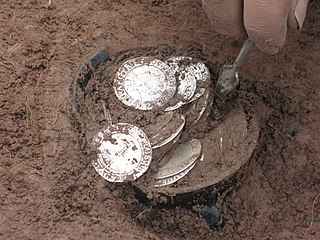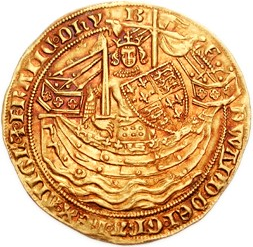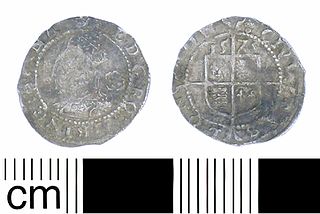 W
WThe Bitterley Hoard is the largest post medieval / English Civil War Coin Hoard found to date from Shropshire, England. It was discovered on 17 February 2011 by a metal detector user near the village of Bitterley, South Shropshire. The find consists of one gold coin and 137 high denomination silver coins. These were placed within a high quality leather purse which was contained within a pottery vessel called a tyg. The earliest coin was from the reign of Edward VI, the latest from the Bristol Provincial Mint of Charles I, indicating it was buried after early 1644.
 W
WConder tokens, also known as 18th-century provincial tokens, were a form of privately minted token coinage struck and used during the latter part of the 18th century and the early part of the 19th century in England, Anglesey and Wales, Scotland, and Ireland.
 W
WThe crown, originally known as the "crown of the double rose", was an English coin introduced as part of King Henry VIII's monetary reform of 1526, with a value of five shillings.
 W
WThe silver three-farthing coin was introduced in Queen Elizabeth I's third and fourth coinages (1561–1582), as part of a plan to produce large quantities of coins of varying denominations and high metal content.
 W
WA farthing was a coin of the Kingdom of England worth one quarter of a penny, 1⁄960 of a pound sterling. Such coins were first minted in England in silver in the 13th century, and continued to be used until the Kingdom of England was merged into the new Kingdom of Great Britain in 1707.
 W
WThe groat is the traditional name of a defunct English and Irish silver coin worth four pence, and also a Scottish coin which was originally worth fourpence, with later issues being valued at eightpence and one shilling.
 W
WThe guinea was a coin, minted in Great Britain between 1663 and 1814, that contained approximately one-quarter of an ounce of gold. The name came from the Guinea region in West Africa, from where much of the gold used to make the coins was sourced. It was the first English machine-struck gold coin, originally worth one pound sterling, equal to twenty shillings, but rises in the price of gold relative to silver caused the value of the guinea to increase, at times to as high as thirty shillings. From 1717 to 1816, its value was officially fixed at twenty-one shillings.
 W
WThe half crown was a denomination of British money, equivalent to two shillings and sixpence, or one-eighth of a pound. The half crown was first issued in 1549, in the reign of Edward VI. No half crowns were issued in the reign of Mary, but from the reign of Elizabeth I half crowns were issued in every reign except Edward VIII, until the coins were discontinued in 1970.
 W
WThe British halfpenny coin was worth 1/480th of a pound sterling. At first in its 700-year history it was made from silver, but as the value of silver increased the coin was made from base metals. It was finally abandoned in 1969 as part of the process of decimalising the British currency. "Halfpenny", colloquially written ha'penny, was pronounced HAY-pə-nee; "1 ½d" was spoken as a penny ha'penny or three ha'pence.
 W
WThe Liudhard medalet is a gold Anglo-Saxon coin or small medal found some time before 1844 near St Martin's Church in Canterbury, England. It was part of the Canterbury-St Martin's hoard of six items. The coin, along with other items found with it, now resides in the World Museum Liverpool. Although some scholarly debate exists on whether or not all the items in the hoard were from the same grave, most historians who have studied the object conclude that they were buried together as a necklace in a 6th-century woman's grave. The coin is set in a mount so that it could be worn as jewellery, and has an inscription on the obverse or front surrounding a robed figure. The inscription refers to Liudhard, a bishop who accompanied Bertha to England when she married Æthelberht the king of Kent. The reverse side of the coin has a double-barred cross, or patriarchal cross, with more lettering.
 W
WThe History of the English penny from 1485 to 1603 covers the period of the Tudor dynasty.
 W
WThe history of the English penny from 1603 to 1707 covers the period of the House of Stuart, up to the Acts of Union of 1707 which brought about the Union of the Kingdom of England with the Kingdom of Scotland.
 W
WThe English penny, originally a coin of 1.3 to 1.5 grams pure silver, was introduced c. 785 by King Offa of Mercia. These coins were similar in size and weight to the continental deniers of the period and to the Anglo-Saxon sceats which had preceded it.
 W
WThe Petition Crown was a pattern coin produced in 1663 by Thomas Simon, a celebrated English medallist and coin-designer. The coin was submitted directly by the artist to King Charles II as a personal 'petition' against the contemporary coins designed by the Flemish brothers John and Joseph Roettiers, and for the further Royal consideration that only Simon's designs be used for all future specie now that machine-made currency had been adopted universally for the production of British coinage.
 W
WThe Rose Ryal is a gold coin of the Kingdom of England issued in the reign of King James I and is now very rare. The coin is really a two-ryal coin worth thirty shillings and is a development of the earlier fine sovereign of Queen Elizabeth I.
 W
WThe St Patrick halfpenny was a milled coin minted in the 17th century in England, Ireland and Wales. The reverse design shows King David kneeling playing a harp while gazing up at the royal crown of England. One peculiarity of the harp is that it bears a semi-nude winged female figure on the pillar, a feature which became common on English coins beginning in the second quarter of the 17th century. The legend on the obverse reads FLOREAT REX.
 W
WA sceat was a small, thick silver coin minted in England, Frisia, and Jutland during the Anglo-Saxon period that normally weighed 0.8–1.3 grams.
 W
WThe sixpence, sometimes known as a tanner or sixpenny bit, is a coin that was worth six pence, equivalent to one-fortieth of a pound sterling, or half of a shilling. It was first minted in 1551, during the reign of Edward VI, and circulated until 1980. Following decimalisation in 1971 it had a value of 2+1⁄2 new pence. The coin was made from silver from its introduction in 1551 until 1947, and thereafter in cupronickel.
 W
WThe English three halfpence, a silver coin worth 1+1⁄2d, was introduced in Elizabeth I of England's third and fourth coinages (1561–1582) as part of a plan to produce large quantities of coins of varying denominations and high silver content. The obverse shows a left-facing bust of the queen, with a rose behind her, with the legend E D G ROSA SINE SPINA – Elizabeth by the grace of God a rose without a thorn – while the reverse shows the royal arms with the date above the arms and a mintmark at the beginning of the legend CIVITAS LONDON – City of London, the Tower Mint.
 W
WThe thrymsa was a gold coin minted in seventh-century Anglo-Saxon England. It originated as a copy of Merovingian tremisses and earlier Roman coins with a high gold content. Continued debasement between the 630s and the 650s reduced the gold content in newly minted coins such that after c. 655 the percentage of gold in a new coin was less than 35%. The thrymsa ceased to be minted after about 675 and was superseded by the silver sceat.
 W
WThe Triple Unite, valued at sixty shillings, 60/- or three pounds, was the highest English denomination to be produced in the era of the hammered coinage. It was only produced during the English Civil War, at King Charles I's mints at Oxford and, rarely, at Shrewsbury in 1642. It weighed 421 grains.
 W
WThe Two Guineas was a gold coin first minted in England in 1664 with a face value of forty shillings. The source of the gold used, also provided the coin its name - the "Guinea", with the regular addition of an elephant or castle symbol on the earliest issues to denote bullion supplied by the Royal African Company. For most of its period of production, the coin weighed between 16.7-16.8 grams and was 31-32 millimetres in diameter, although the earliest coins of Charles II were about 0.1 grams lighter and 1 millimetre smaller.
 W
WThe unite was the second English gold coin first produced during the reign of King James I. It was named after the legends on the coin indicating the king's intention of uniting his two kingdoms of England and Scotland. The unite was valued at twenty shillings until 1612 when the increase in the value of gold throughout Europe caused it to be raised to twenty-two shillings. The coin was produced during James I's second coinage (1604–1619), and it was replaced in the third coinage by the Laurel worth twenty shillings. All the coins were produced at the Tower Mint in London.